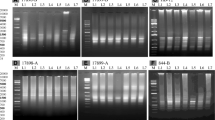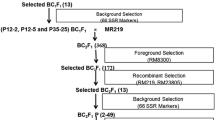Abstract
New rice lines, restorer line RB207 and maintainer line Yewei B, with better agronomic traits were separately developed from variant progeny of R207 (rice restorer line) and V20B (rice maintainer line) through transformation of genomic DNA ofEchinochloa crusgalli (C4 plant) andOryza minuta, respectively. The phenotypes of the variant lines were apparently different from those of the receptors. Yewei B had stronger tolerance to high temperature than did V20B. The number of spikelets per panicle and the 1000-grain weight of RB207 increased by 40% over those of R207. The results of amplified fragment length polymorphism (AFLP) analysis indicated that the polymorphism rates were both 4.4% between genomes of the variant lines and their receptors. Results demonstrated that special DNA segments fromE. crusgalli andO. minuta might integrate into the genome of cultivated rice and could be stably passed on. The study further shows that transformation of genomic DNA of distant relatives is an effective approach for creating new rice germ plasm.
Similar content being viewed by others
Abbreviations
- AFLP:
-
amplified fragment length polymorphism
- PCR:
-
polymerase chain reaction
- RAPD:
-
random amplification of polymorphic DNA
- RFLP:
-
restriction fragment length polymorphism
References
Bijoya B, Aniruddha PS, and Hari SG (1999) Transfer of wild abortive cytoplasmic male sterility through protoplast fusion in rice. Mol Breed 5: 319–327.
Brar S and Khush GS (1997) Alien introgression in rice. Plant Mol Biol 35: 35–47.
Jia JH, Zhang DS, Li CY, Qu XP, Wang SW, Chamarerk V, Nguyen HT, and Wang B (2001) Molecular mapping of the reverse thermo-sensitive genic male-sterile gene (rtms1) in rice. Theor Appl Genet 103: 607–612.
Ku MSB, Sakae A, Mira N, Hiroshi F, Hiroko T, Kazuko O, Sakiko H, Mitsue M, and Makoto M (1999) High-level expression of maize phosphoenopyruvate carboxylase in transgenic rice plant. Nat Biotechnol 17: 76–80.
Lee SI, Lee SH, Koo JC, Chun HJ, Lim CO, Mun JH, Song YH, and Cho MJ (1999) Soybean kunitz trypsin inhibitor (SKTI) confers resistance to the brown planthopper (Nilaparvata lugens stal) in transgenic rice. Mol Breed 5: 1–9.
Lei BJ, Liu CH, Qian H, Li XC, Zhou SJ, Lu YB, Zhao K, Liu GY, Yang XY, Xie WW, and Wang B (1996) Early maturing lines of obtained through foreign total DNA introduction in soybean [in Chinese with English abstract]. Acta Agron Sinica 22: 173–177.
Lima MLA, Garcia AAF, Oliveira KM, Matsuoka S, Arizono H, de Souza CL Jr, and de Souza AP (2002) Analysis of genetic similarity detected by AFLP and coefficient of parentage among genotypes of sugar cane (Saccharum spp.). Theor Appl Genet 104: 30–38.
Liu B, Li XW, and Liu ZL (1999) Production of a highly asymmetric somatic hybrid between rice andZizania latifolia (Griseb): evidence for inter-genomic exchange. Theor Appl Genet 98: 1099–1103.
Liu ZL, Dong YZ, and Liu B (2000) Isolation ofZizania latifolia species-specific DNA sequences and their utility in identification ofZ. latifolia DNA introgressed into rice. Acta Bot Sinica 42: 324–326.
Manifesto MM, Schlatter AR, Hopp HE, Suarez EY, and Dubcovsky J (2001) Quantitative evaluation of genetic diversity in wheat germ plasm using molecular markers. Crop Sci 41: 682–690.
McCouch SR, Kochert G, Yu ZH, Wang ZY, Khush GS, Coffman WR, and Tanksley SD (1988) Molecular mapping of rice chromosomes. Theor Appl Genet 76: 815–829.
Miao J, Zhao MA, and Li WQ (2000) Molecular evidences for total DNA transformation fromLeymus racemouses to wheat [in Chinese]. Acta Genet Sinica 27: 621–627.
Pena DL, Lorz H, and Schell (1987) Transgenic rye plant obtained by injecting DNA into young floral tillers. Nature 325: 274–276.
Tanksley SD, Ganal MW, and Martin GB (1995) Chromosome landing, a paradigm for map-based gene cloning in plants with large genomes. Trends Genet 11: 63–68.
Vos P, Hogers R, Bleeker M, Reigans M, Lee T, Hornes M, Frijters A Pot J, Peleman J, Kuiper M, and Zabeau M (1995) AFLP: a new technique for DNA fingerprinting. Nucleic Acids Res 23: 4407–4414.
Xiao JH, Grandllo S, Ahn SN, McCouch SR, Tanksley SD, and Yuan LP (1996) Genes from wild rice improve yield. Nature 384: 223–224.
Yan HH, Yiu GQ, Chen ZK, Min SK, and Zhu LH (2001) Characterization of euploid backcross progenies derived from interspecific hybrids betweenOryza sativa andOryza eichingeri by restriction fragment length polymorphism (RFLP) analysis and genomic in situ hybridization (GISH). Genome 44: 86–95.
Ye XD, Al-Babili S, Kloti A, Zhang J, Lucca P, Beyer P, and Potrykus I (2000) Engineering the provitamin A (β-carotene) biosynthetic pathway into (carotenoid-free) rice endosperm. Science 287: 303–305.
Yuan LP (1997) Hybrid rice breeding for super high yield [in Chinese and English]. Hybrid Rice 63: 1–6.
Zhai WX, Wang WM, Zhou YL, Li XB, Zheng XW, Zhang Q, Wang GL, and Zhu LH (2002) Breeding bacterial blight-resistant hybrid rice with the cloned bacterial blight resistance gene Xa21. Mol Breed 8: 285–293.
Zhang FQ, Jiang JX, Li ZD, Zheng SX, and Zhou GY (2000) Studies on variation of introducing cotton DNA into ramie [in Chinese with English abstract]. Sci Agric Sinica 33: 104–106.
Zhao BR, Huang JL, Liu CL, Fu XQ, Li HS, and Yuan LP (1998) A study on the transportation way of exogenous DNA in vivo and a female sterile variation of rice [in Chinese with English abstract]. J Hung Agric Univ 116: 436–441.
Zhao BR, Jia JH, Wang Q, Wang B, and Yuan LP (2001) Comparison of the nucleotide sequence of the specific DNA fragments between the variation line and its donor [in Chinese with English abstract]. Hybrid Rice 87: 46–49.
Zhao BR, Jia JH, Yang HH, Li CY, Zhan QC, Wang B, Zhou KL, and Yuan LP (2000) RAPD analysis of new rice strains developed through the method of spike-stalkinjecting DNA from wild relative. Acta Agron Sinica 26: 424–430.
Zhou GY, Chen SB, and Huang JQ (1993) Advances in Molecular Breeding Research of Agriculture [in Chinese with English abstract]. Chinese Agricultural Science Press, Beijing.
Zhou JL, Li YS, and Li DM (2001) Analysis of RAPD pattern and iron-toxicity of variations induced by introducingE. crusgalli DNA into rice [in Chinese with English abstract]. Acta Agron Sinica 27: 529–532.
Author information
Authors and Affiliations
Corresponding author
Additional information
These authors contributed equally to this work.
Rights and permissions
About this article
Cite this article
Xing, Q., Zhao, B., Xu, K. et al. Test of agronomic characteristics and amplified fragment length polymorphism analysis of new rice germplasm developed from transformation of genomic DNA of distant relatives. Plant Mol Biol Rep 22, 155–164 (2004). https://doi.org/10.1007/BF02772722
Issue Date:
DOI: https://doi.org/10.1007/BF02772722




